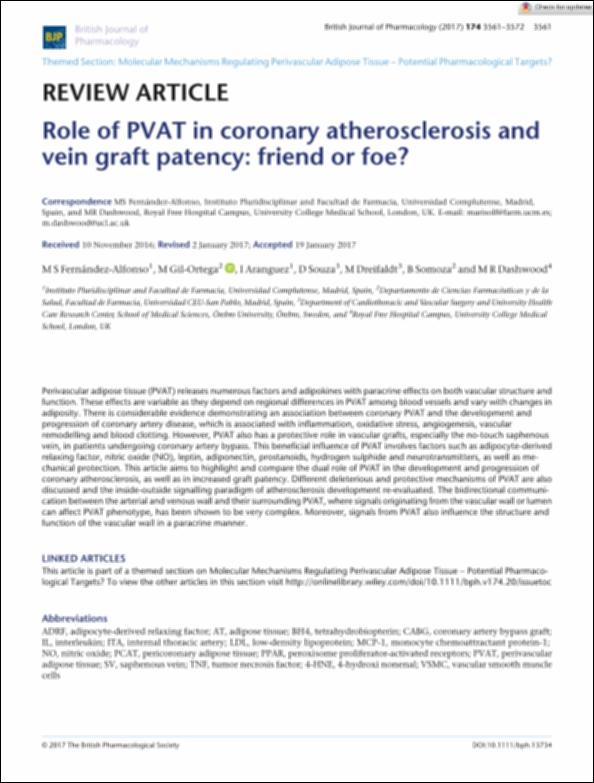Please use this identifier to cite or link to this item:
http://hdl.handle.net/10637/14617Role of PVAT in coronary atherosclerosis and vein graft patency friend or foe?
| Title: | Role of PVAT in coronary atherosclerosis and vein graft patency friend or foe? |
| Authors : | Fernández Alfonso, María Soledad Gil Ortega, Marta Aránguez, Isabel Souza, D Dreifaldt, M Somoza Hernández, Beatriz Dashwood, M. R. |
| Publisher: | British Pharmacological Society |
| Citation: | Fernández-Alfonso MS, Gil-Ortega M, Aranguez I, Souza D, Dreifaldt M, Somoza B, Dashwood MR. Role of PVAT in coronary atherosclerosis and vein graft patency: friend or foe? Br J Pharmacol. 2017 Oct;174(20):3561-3572. doi: 10.1111/bph.13734. Epub 2017 Mar 2. |
| Abstract: | Perivascular adipose tissue (PVAT) releases numerous factors and adipokines with paracrine effects on both vascular structure and function. These effects are variable as they depend on regional differences in PVAT among blood vessels and vary with changes in adiposity. There is considerable evidence demonstrating an association between coronary PVAT and the development and progression of coronary artery disease, which is associated with inflammation, oxidative stress, angiogenesis, vascular remodelling and blood clotting. However, PVAT also has a protective role in vascular grafts, especially the no-touch saphenous vein, in patients undergoing coronary artery bypass. This beneficial influence of PVAT involves factors such as adipocyte-derived relaxing factor, nitric oxide (NO), leptin, adiponectin, prostanoids, hydrogen sulphide and neurotransmitters, as well as mechanical protection. This article aims to highlight and compare the dual role of PVAT in the development and progression of coronary atherosclerosis, as well as in increased graft patency. Different deleterious and protective mechanisms of PVAT are also discussed and the inside-outside signalling paradigm of atherosclerosis development re-evaluated. The bidirectional communication between the arterial and venous wall and their surrounding PVAT, where signals originating from the vascular wall or lumen can affect PVAT phenotype, has been shown to be very complex. Moreover, signals from PVAT also influence the structure and function of the vascular wall in a paracrine manner. |
| Description: | Este artículo es parte de "Molecular Mechanisms Regulating Perivascular Adipose Tissue – Potential Pharmacological Targets", http://onlinelibrary.wiley.com/doi/10.1111/bph.v174.20/issuetoc |
| URI: | http://hdl.handle.net/10637/14617 |
| Rights : | http://creativecommons.org/licenses/by-nc-nd/4.0/deed.es OpenAccess |
| ISSN: | 1476-5381 |
| Issue Date: | 1-Feb-2017 |
| Center : | Universidad San Pablo-CEU |
| Appears in Collections: | Facultad de Farmacia |
Items in DSpace are protected by copyright, with all rights reserved, unless otherwise indicated.


